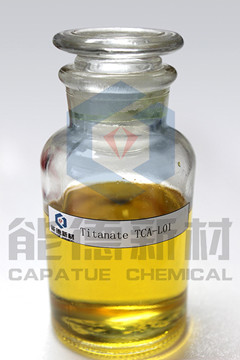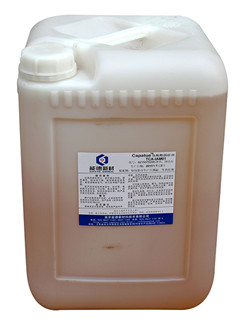

|
Chemical Name: |
Titanium IV 2,2(bis 2-propenolatomethyl) butanolato, tris neodecanoato-O |
|
CAS No: |
103334-85-6 |
|
Molecular Structure: |
|
Equivalents:
|
Product |
Supplier |
|
LICA 01 |
Kenrich Petrochemicals, Inc |
Typical Properties:
|
Index |
Value |
|
Appearance |
Reddish Orange liquid |
|
Solids (in IPA Solvent),% |
> 99 |
|
Viscosity,cps@25℃(770F) |
700~1200 |
|
Specific Gravity @16℃(60 ℉) |
1.02 土0.02 |
|
Flash Point, (TCC) |
>150 ℉ (>60 ℃) |
|
Solubility |
> 5% in xylene, toluene, isopropyl alcohol, mineral oil, DOP, DIDP, aromatic plasticizer, and MEK. Insoluble in H20 at >1 %. Directly water emulsifiable with no other surfactants needed. |
Product appearance:

Abstract:
TCA-L01 is a neoalkoxy phosphate titanate coupling agent; it has an enhanced final properties compared to traditional monoalkoxy titanates.
Applications and Performance:
Coupling Agents are molecular bridges at the interface between two substrates, usually but not limited to an inorganic filler/fiber and an organic polymer matrix. Titanium-derived coupling agents react with free protons at the inorganic interface resulting in the formation of organic-titanium monomolecular layers on the inorganic surface. Additionally, the coupling agent may have up to Six Functions in the matrix-which include polymer catalysis and other heteroatom effects-independent of inorganic content.
Typically, titanate-treated inorganics are hydrophobic, organophilic, and organofunctional. Fillers may be pretreated or treated in situ absent water of condensation and drying techniques as needed with silanes. When used in polymers, titanates can increase adhesion ;improve impact strength and mechanical properties; reduce embrittlement; allow higher filler loadings; optimize particulate dispersion; increase flow of filled and unfilled polymers at lower process temperatures; prevent phase separation; and may have other effects (see “Suggested Functions”).
Suitable Substrates- The proton reactivity of titanate allows coupling to almost all inorganic and organic substrates such as CaCO3, carbonates, carbon black, graphite, minerals, nano-particulates, silicas, silicates, metals, metal oxides, peroxides, hydrates, acetates, borates, sulfates, nitrates, nitramines, aramid, organic pigments, cellulosics, sulfur, azodicarbonamide, polymers, etc.
Suggested Functions- Coupling agent, adhesion promoter, catalyst, repolymerization catalyst, copolymerization catalyst, regrind regenerator, polymer strain and mechanical property improver, dispersion aid, deagglomerator, wetting agent, surfactant, grinding aid , plasticizer or solvent reducer, superplasticizer, low temperature flexibilizer, process aid, peptizer, flow control agent, lubricant, viscosity depressant, thixotrope, suspension aid, impact modifier, comonomer, Lewis Acid reducing agent, hydrophobic agent, cure rate modifier, blowing agent activator, intumescent activator, flame retardant, conductivity enhancer, corrosion inhibitor, anti-aging inhibitor, etc. Function depends on dosage, solubility parameters, dilution, sequencing, process conditions, substrate, polymer, other ingredients, curatives, etc. and their interaction with the chemical functionalities of TCA-L01.
Recommend Dosage- Titanate TCA-L01 use level can vary from ppm when used as a catalyst in synthesis to 0.2% to 0.6% by weight of polymer(s) when used as a polymer regeneration catalyst or copolymerization catalyst in the macromolecular melt. A general rule of thumb is to use 0.2 wt. % of polymer or 0.2 to 0.5 wt. % of filler, whichever is the greater. Typically, a 2.7 S.G., 2.5μ mineral filler such as CaCO3 will require 0.2 to 0.4 wt. % titanate. 0.1 to 0.6 wt. % of total polymer matrix is a good range for ladder studies. Amounts to as much as 3% are is also often used.
Some Commercial Applications-There is many references in the literature citing the use of TCA-L01. Originally conceived to provide amino thermoset reactivity, applications have expanded to include: dispersion aid and physical property enhancer for use on the hardener side of nitrogen based epoxy curatives; catalyst for phenolic resin manufacture; urethane catalyst –twenty-two times faster than DBTDL in 2-component urethanes;TiO2/Zn Molybdate/silicone-alkyd marine deck coatings; increased tensile and flexibility of CaCO3 filled flexible PVC; chemical reactivity for property enhancement of halogenated polymers; adhesion promoter for epoxy, acrylic and urethane coatings to metals and polymers; increased properties of Kevlar (aramid) reinforced, amide and anhydride cured epoxies; increased conductivity of metal powder filled polymers, etc.
Some Typical Applications:
1. Wood Plastic Composite (WPC): Commingled post-consumer waste plastics melt blended with Pinus Radiata fiber and neoalkoxy titanate form composite materials with higher tensile strengths of the order of 30% to 50%.
2. Plastic Alloy: Titanate may act as compatabilizers via activation of both addition and condensation polymers. When the activation occurs to more than one polymer simultaneously (in the absence or presence of filler or reinforcement – both inorganic and organic, or peroxide) repolymerization manifests itself as copolymerization (i.e. intermolecular rearrangement), or grafting, or other molecular modifications. The result is some form of superior "chemical alloying" as opposed to inferior “physical alloying”. Activation of both addition and condensation polymers by selected organometallics may result in catalysis and a wide variety of copolymerization reactions:
• Rapid equilibration of molecular weights to produce near thermodynamic equilibrium distribution irrespective of starting compositions.
• Randomization of most block copolymers except some aliphatic polyethers.
• Reduction in polydispersity of molecular weight resulting in a narrower molecular weight distribution curve.
• Controlled introduction of organofunctional groups for bonding enhancement.
3. Recycle and Regrind Thermoplastics: With “Repolymerization” function, thermoplastics may be regenerated to virgin or recycled more efficiently since the thermally stable titanate ester forms of subject organometallics “anneal” or “reconnect” polymer chain lengths that are normally “scissored” during processing. For example, HDPE regrind from blow molding operations can be regenerated to virgin-like properties and LDPE regrind/PP regrind at 80/20 polyblended in a twin screw extruder will show significantly increased HDT, melt flow, tensile modulus and elongation using TiLinkTM TCA-L01 at 0.2% by weight of the polyblend against a control.
4. Injection and Blow Molding: - 0.2% TiLinkTM TCA-L01 on average will reduce injection and blow mold cycle times by 19% and process temperatures by 9%. Up to 40% cycle time reductions even could be achieved. Typically, just a 4% cycle time reduction for a fully utilized production capital equipment setup pays the cost (US$8.5/kg.) of the additive and further reductions fall to the bottom line as profit. Furthermore TiLinkTM TCA-L01 could let you use less plastic to equivalent strengths - particularly in blow molded thermoplastics where outer dimensions are unaffected by thinner gauging. For example, a HDPE marine fuel tank uses 1% TiLinkTM TCA-L01 to reduce cycle time from 186 to 116 seconds at lower process temperature while reducing part weight from 1745 grams to 1500 grams to equivalent drop weight impact strength. The strength tests consisted of 3+-meter drop-weight impact of water filled containers and two-year UV exposure of fuel filled containers.
5. Foamed Polymers:- Create finer more uniform foamed polymers since open cell formation is reduced because increased polymer strain strength at elevated temperatures induced by the additive prevents the polymer bubbles from breaking during the elevated temperature where blow occurs.
Packing:
This product is available in 20kg pail, 200L drums and 1000L immediate bulk container.

Storage and Shelf Life:
Should be stored in dry, cool, ventilated room; keep away from water, moisture, high temperature and fire. This product has a shelf life of at least 12 months if stored in tightly closed original container at room temperature.
If this product is kept beyond the shelf life recommend on the product label, it is not necessarily unusable, but a quality control should be performed on the properties relevant to the application.
